| JANUARY 2025 |
| Kabukiza (T˘ky˘) |  |
| Dates | 2 ~ 26 January 2025 Kotobuki Hatsuharu ďkabuki Congratulation Early Spring Grand Kabuki |
| MatinÚe |
Onmy˘ji
|
| Evening |
Ichi-no-Tani Futaba Gunki (Kumagai Jin'ya) Daifug˘ D˘shin |
| Casting |
Living National Treasure Nakamura Karoku, Living National Treasure Nakamura T˘z˘, Matsumoto Haku˘, Nakamura Manju, Nakamura Shikan, Nakamura Kaishun, Nakamura Jakuemon, Matsumoto K˘shir˘, Nakamura Ganjir˘, Nakamura Senjaku, Nakamura Kankur˘, Onoe Sh˘roku, Kataoka Takatar˘, Nakamura Kazutar˘, Ichikawa Chűsha, Nakamura Hayato, Band˘ Minosuke, Ichikawa Monnosuke, Band˘ Kamez˘, Nakamura Yonekichi, Ichikawa Emiya, Ichikawa Emisabur˘, Ichikawa En'ya, Ichikawa Komaz˘, Matsumoto Kingo, Band˘ Shingo, Onoe Ukon, ďtani Keiz˘, Nakamura Matsue, Nakamura Kikaku, ďtani Hirotar˘, Sawamura S˘nosuke, Nakamura Kichinoj˘, Nakamura Jűjir˘, Ichikawa Juen, Ichikawa Seiko, Sawamura Kiyoshir˘ |
| Comments |
The two programs for the New Year Grand Kabuki at the Kabukiza.
|
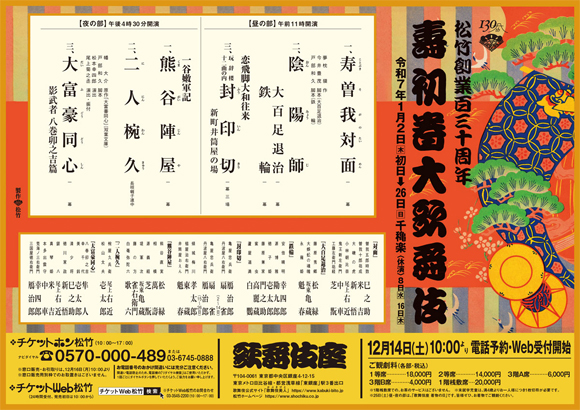 |
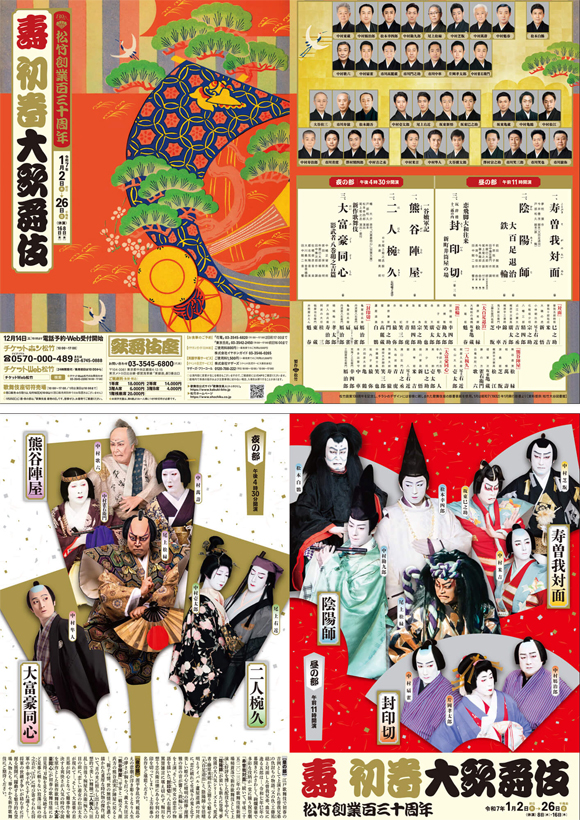 |
 |
| New National Theatre (T˘ky˘) |  |
| Dates | 5 ~ 27 January 2025 Reiwa 7 Hatsuharu Kabuki 7th Year of the Reiwa Era Early Spring Kabuki |
| Program |
Hikosan Gongen Chikai no Sukedachi
|
| Casting |
Living National Treasure Onoe Kikugor˘, Onoe Kikunosuke, Band˘ Rakuzen, Band˘ Hikosabur˘, Nakamura Tokiz˘, Nakamura Matagor˘, Nakamura Mantar˘, Kamimura Kichiya, Kataoka Kamez˘, Kawarasaki Gonjűr˘, Ichimura Manjir˘, Ichimura Takematsu, Ichimura Kitsutar˘, Onoe Ushinosuke, Onoe Maholo, Kamimura Kichitar˘, Nakamura Baishi, Band˘ Kamesabur˘, Ichimura Hikaru, Nakamura Tanetar˘, Nakamura Hidenosuke |
| Comments |
No performance at the National Theatre, which was destroyed in 2024, but there is a subsitute theater: the New National Theatre!
|
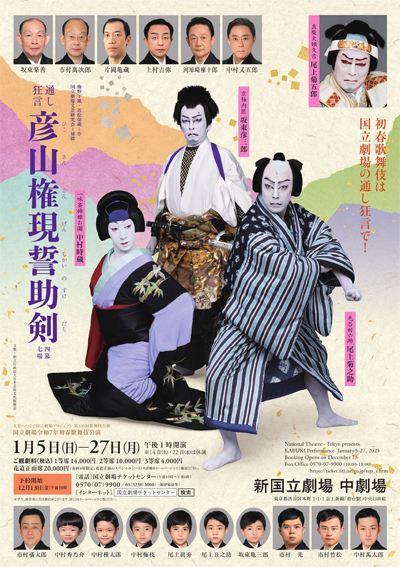 |
| Sh˘chikuza (ďsaka) |  |
| Dates | 1 ~ 8 January 2025 Band˘ Tamasabur˘ Hatsuharu Otoshidama K˘en Band˘ Tamasabur˘ Early Spring New Year's Gift Performances |
| Program |
Zangetsu Nagasaki Jűnikei |
| Casting |
Living National Treasure Band˘ Tamasabur˘ |
| Comments |
A special Buy˘ program in ďsaka at the Sh˘chikuza starring the amazing Living National Treasure onnagata Band˘ Tamasabur˘.
|
 |
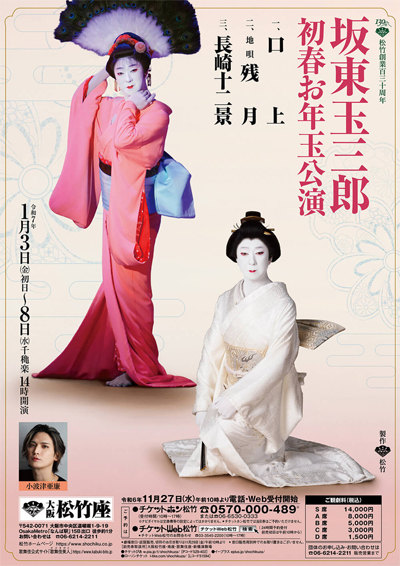 |
| Dates | 11 ~ 26 January 2025 Kataoka Nizaemon Band˘ Tamasabur˘ Hatsuharu Tokubetsu K˘en Kataoka Nizaemon Band˘ Tamasabur˘ Early Spring Special Performances |
| Program |
Osome Hisamatsu Ukina no Yomiuri |
| Casting |
Living National Treasure Band˘ Tamasabur˘, Living National Treasure Kataoka Nizaemon, Band˘ Yajűr˘, Nakamura Kinnosuke, Kataoka Matsunosuke |
| Comments |
A special Kabuki program starring starring the goruden konbi Living National Treasures Band˘ Tamasabur˘ and Kataoka Nizaemon.
|
 |
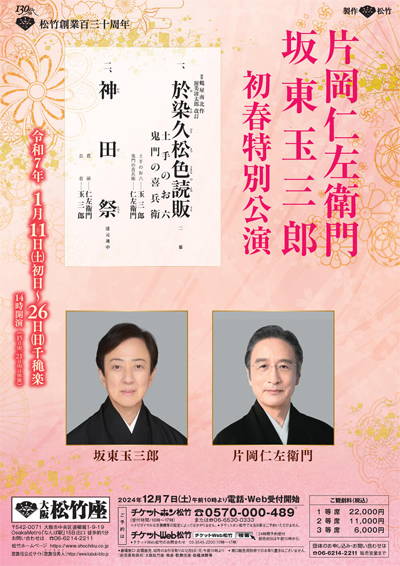 |
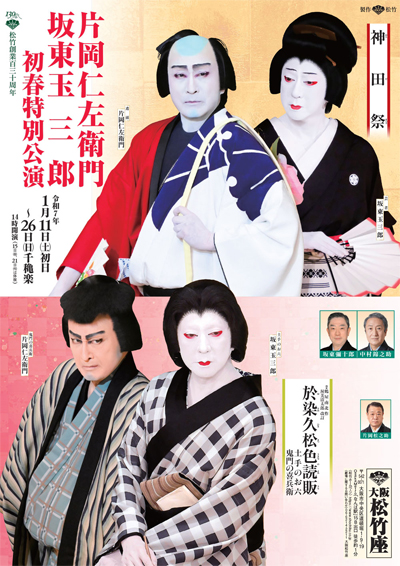 |
| Shinbashi Enbuj˘ (T˘ky˘) |  |
| Dates | 3 ~ 26 January 2025 Hatsuharu Kabuki K˘en Early Spring Kabuki Performances |
| MatinÚe |
Narabegaki Manete Mimasu [ |
| Evening |
Narabegaki Manete Mimasu [ |
| Casting |
Ichikawa Danjűr˘, Living National Treasure Nakamura Baigyoku, Ichikawa Udanji, Nakamura Kotar˘, Kataoka Ichiz˘, Ichikawa Omez˘, Ichikawa Kudanji, Nakamura Kash˘, Nakamura Tanenosuke, Ichikawa Shinnosuke, ďtani Hiromatsu, Nakamura Toranosuke, Nakamura Fukunosuke, Nakamura Utanosuke, Ichikawa Otora, Nakamura Baika, Ichikawa Ukon, Ichikawa Botan |
| Comments |
The traditional New Year Kabuki at the Shinbashi Enbuj˘ with a troupe led by Ichikawa Danjűr˘.
|
 |
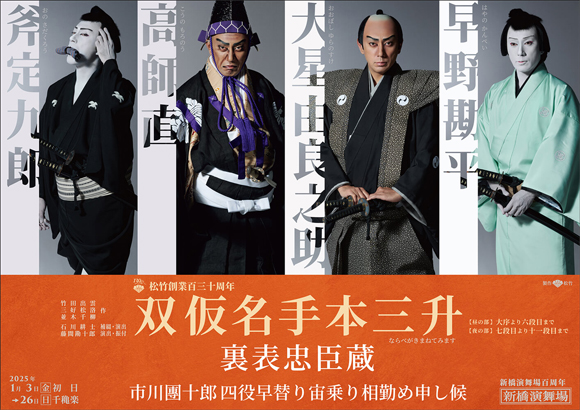 |
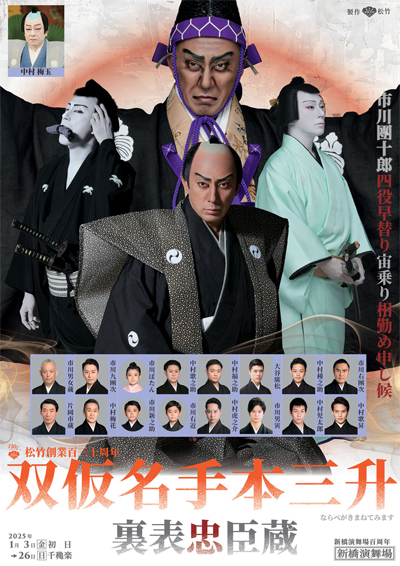 |
|
|||
| Dates | 2 ~ 26 January 2025 Shinshun Asakusa Kabuki New Year Asakusa Kabuki |
||
| MatinÚe |
Otoshidama (Nenshi Goaisatsu) |
||
| Evening |
Otoshidama (Nenshi Goaisatsu) Haru no Shirabe Musume Nanakusa |
||
| Casting |
Nakamura Hashinosuke, Ichikawa Somegor˘, Nakamura Kangyoku, Nakamura Takanosuke, Nakamura Tsurumatsu, Onoe Sakon, Nakamura Tamatar˘, Nakamura Kamenoj˘ |
||
| Comments |
The yearly show for young promising actors at the Asakusa K˘kaid˘ in Asakusa, a lively and colorful neighboorhood that keeps the scent of old Edo.
|
||
 |
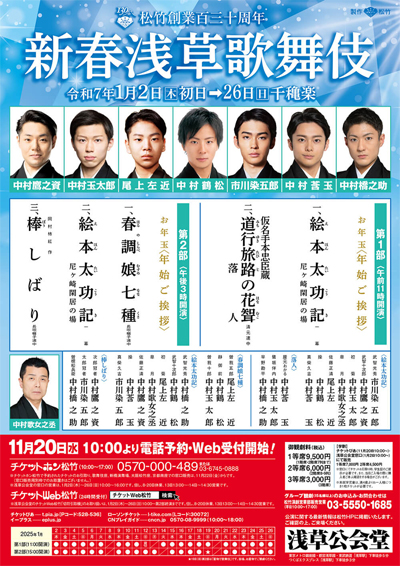 |
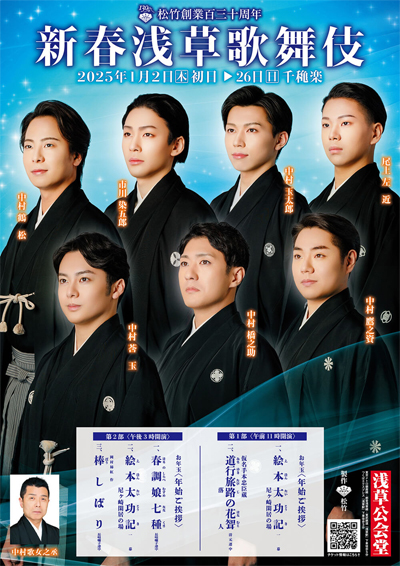 |
|
|
| Contact | Main | Top | Updates | Actors | Plays | Playwrights | Programs | Links | FAQ | Glossary | Chronology | Illustrations | Prints | Characters | Derivatives | Theaters | Coming soon | News |